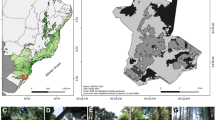Summary
Leaf-cutting ants (Formicidae; Attini) characteristically never attack some common plant species in their habitats. These plants may be defended against the ants in several ways. In Texas, mature leaves of Sapindus saponaria (Sapindaceae) and Celtis reticulata (Ulmaceae) are unpalatable to Atta texana Buckley foragers, while mature leaves of Berberis trifoliata (Berberidaceae) are palatable to the ants, but are too tough to cut. Young Celtis leaves and and young Berberis leaves are palatable and can be cut by the ants, however. These young leaves may escape attack by remaining palatable a brief amount of time (new Celtis leaves), or by occurring patchily in space and time (new Berberis leaves).
Similar content being viewed by others
References
Bowers MA, Porter SD (1981) Effect of foraging distance on water content of substrates harvested by Attaccolumbica (Guerin). Ecology 62:273–275
Cherrett JM (1968) A simple penetrometer for measuring leaf toughness in insect feeding studies. J Econ Entomol 61:1736–1738
Cherrett JM (1972) Some factors involved in the selection of vegetable substrate by Atta cephalotes (L.) (Hymenoptera: Formicidae) in tropical rain forest. J Anim Ecol 41:647–660
Erickson JM, Feeny P (1974) Sinigrin: a chemical barrier to the black swallowtail butterfly, Papilio polyxenes. Ecology 55:103–111
Feeny P (1970) Seasonal changes in oak leaf tannins and nutrients as a cause of spring feeding by winter moth caterpillars. Ecology 51:565–581
Littledyke M, Cherrett JM (1976) Direct ingestion of plant sap from cut leaves by the leaf-cutting ants Atta cephalotes (L.) and Acromyrmex octospinosus (Reich) (Hymenoptera: Formicidae). Bull Entomol Res 66:205–217
Littledyke M, Cherrett JM (1978a) Defense mechanisms in young and old leaves against cutting by the leaf-cutting ants Atta cephalotes (L.) and Acromyrmex octospinosus (Reich) (Hymenoptera: Formicidae). Bull Entomol Res 68:263–271
Littledyke M, Cherrett JM (1978b) Olfactory responses of the leaf-cutting ants Atta cephalotes (L.) and Acromyrmex octospinosus (Reich) (Hymenoptera: Formicidae) in the laboratory. Bull Entomol Res 68:273–282
Rockwood LL (1976) Plant selection and foraging patterns in two species of leaf-cutting ants (Atta). Ecology 57:48–61
Rockwood LL (1977) Foraging patterns and plant selection in Costa Rican leaf-cutting ants. J New York Entomol Soc LXXXV:222–233
Stradling DJ (1978) The influence of size on foraging in the ant, Atta cephalotes, and the effect of some plant defence mechanisms. J Anim Ecol 47:173–188
Woodhead S, Bernays E (1977) Changes in release rates of cyanide in relation to palatability of Sorghum to insects. Nature 270:235–236
Author information
Authors and Affiliations
Rights and permissions
About this article
Cite this article
Waller, D.A. Leaf-cutting ants and avoided plants: Defences against Atta texana attack. Oecologia 52, 400–403 (1982). https://doi.org/10.1007/BF00367966
Received:
Issue Date:
DOI: https://doi.org/10.1007/BF00367966




